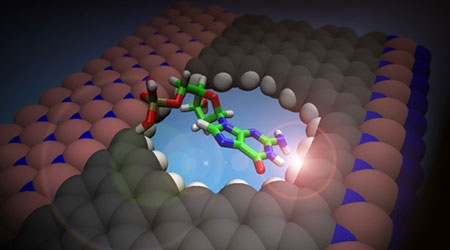| Posted: Feb 15, 2017 |
New type of nanosensor detects DNA building blocks
(Nanowerk News) Researchers at Uppsala University and in Brazil have developed a new type of nanosensor that can detect single molecules. The nanosensor, comprising a combination of two different materials, has been used to identify the different building blocks in DNA.
|
|
What is really groundbreaking about this study (Nanoscale, "Electrical detection of nucleotides through the nanopore in hybrid graphene/h-BN sheet") is that it has succeeded in combining graphene, which is electrically conductive, and boron nitride, which is insulating, in the same two-dimensional material. Previously, these two substances have only been used separately in an attempt to detect molecules.
|
 |
| A molecule’s dipole moment affecting the electrical potential of an atomic chain and thus altering the electrical current in the material. (Image: Ralph Scheicher)
|
|
The detection of individual molecules is of great importance in medicine and health care, but currently available methods are generally too complicated and expensive to be used widely.
|
|
The study has applied the nanosensor to detect the four naturally occurring nucleotides, which are the building blocks of DNA, and thus discovered a new quick and inexpensive way to sequence DNA by measuring an electric current.
|
|
In computer simulations, a little hole, called a nanopore, was created at the interface between the two substances, and a small chain of electrically conductive material thus formed between the nanopore and the insulating boron nitride. When molecules move through the nanopore, the electric potential of the chain is modulated and the conductivity of the material is therefore affected. By measuring the electric current in the material, the molecules can be identified through their characteristic dipole moment.
|
|
The study also included hydrogen fluoride, a small molecule with a large electric dipole moment, which is an ideal model system to get a better understanding of how the nanosensor can detect the larger and more complex molecules.
|
|
“Computer simulations were carried out in a vacuum, and the molecules were fixed relative to the carbon chain and nanopore. In future studies, we want to examine the dynamic aspects of the system. It will be exciting, for example, to see how the sensors react to water”, says Ralph Scheicher, Assistant Professor of Materials Theory at the Department of Physics and Astronomy.
|

